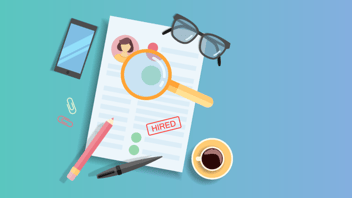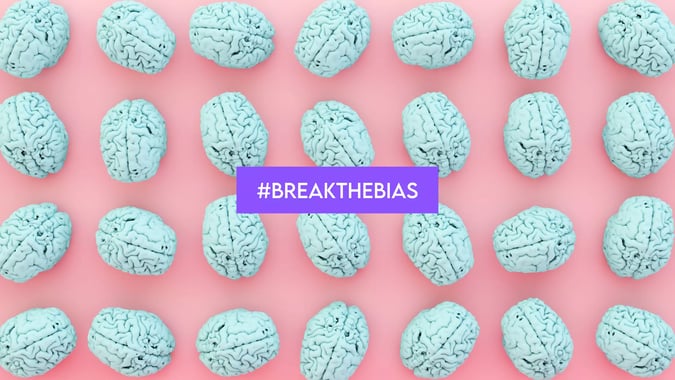
Don’t trust your gut: How to break your brain’s biases

If you have a brain, you are biased. While not all types of bias are bad - like staying away from something dangerous, many human biases can be harmful – resulting in discrimination, inequity and a lack of diversity and inclusion.
International Women’s Day (IWD) for 2022 explores the theme of bias, how to #BreakTheBias and create a more diverse, equitable, and inclusive world where we value and celebrate our differences.
What is bias and how do they get there?
Bias is our inclination or tendency towards or against something or someone. Human bias is developed at an early age to help us navigate the world.
Our brains make sense of the world by categorising things, looking for patterns and associations to process new information and people.
The Kirwan Institute (for the study of race and ethnicity) at Ohio State University defines implicit or unconscious biases as “the attitudes or stereotypes that affect our understanding, decisions and actions in an unconscious manner. These implicit biases we all hold do not necessarily align with our own declared beliefs.”
Scientists have identified more than 150 different types of biases, many of which are unconscious. Check out this infographic of the types of bias.
Similarity bias for example is the tendency to be attracted to “people like me” and think they are better than others. Think about how you naturally gravitate towards people with shared life experiences when you are at a party.
The impact of unconscious bias
While biases are a normal human way of distilling information, biases can unintentionally influence our decision-making as our brains make automatic associations and assumptions about other people or groups of people based on cultural stereotypes.
Regardless of how fair-minded we consider ourselves to be, the challenge with our brains is that we can’t just take something unconscious and make it conscious. It’s not possible to be aware of unconscious processes in the moments that we make choices or decisions as it’s a different way of processing things in your brain.
Even if we are educated about our biases, it won’t necessarily lead to better decision-making. But awareness can help us understand and reflect on the ways we have been biased in the past, to avoid repeating the behaviour in the future.
Biases affecting the workplace
Unconscious bias can have a significant influence on our behaviours and decision making in the workplace.
Biases are often based on stereotypes, rather than actual knowledge of an individual or circumstance. These cognitive shortcuts can result in prejudgments that lead to rash decisions or discriminatory practices.
Bias can also be experienced at an organisational level, with collective unconscious patterns influencing company decisions, affecting diversity and representation. Effectively managing bias in the workplace can increase creativity, innovation, and performance, support effective communication, and lead to higher work fulfilment.
Check your bias
A consortium of researchers from Harvard University, the University of Virginia, and the University of Washington have developed an effective tool for people to test their own unconscious bias. The Implicit Association Test (IAT) is an interesting way of uncovering how your brain automatically processes information that leads to bias.
Breaking the bias
Recognising and interrupting our own biases and those of others can help break patterns of the past. Because we need to interrupt our implicit biases to change, ‘trusting your gut’ won’t help the process.
The SEEDS model offers a brain-based alternative to mitigating bias, identifying processes to interrupt and redirect unconsciously biased thinking.
The SEEDS model simplifies the 150+ types of identified cognitive biases into five categories (similarity, expedience, experience, distance, safety) with a different set of actions that go to the core processes underlying each type of bias to help mitigate the bias.
Preparation is key
Understanding where unconscious bias can affect decision making is key to changing the context surrounding the decision. Hiring or promoting staff is a prime example – recognising in advance that we are more likely to favour people like ourselves through similarity bias. More than just being aware of the biases involved, being prepared for this situation in advance and changing the underlying processes can help mitigate the bias involved and create a more equitable outcome.
The SEEDS model can be applied using 3 steps:
- ACCEPT that people and systems are inherently biased, and don’t know it.
- LABEL the types of bias likely to occur using the SEEDS model.
- MITIGATE using strategies that go directly to the core processes underpinning the bias.
Breaking the bias for women re-entering the workforce
Women who have been out of the workforce for an extending period often find it difficult to return to work, impacting the representation of women in the workforce and fuelling the gender pay gap. In Australia, workforce representation for females falls 9.5% behind males, with managers almost twice as likely to be men (61.4%) than women (38.6%).
The pandemic hasn’t helped this situation, with 61% of job losses between February and October 2021 experienced by women (81% in Victoria).
While the majority of women attempting to return to the workforce after a break experience low confidence and feel they need to upskill before returning to work, women with children are often ignored when applying for jobs, further decreasing participation and negatively impacting superannuation for women at retirement.
The Encoreship program was developed to interrupt this bias, helping women return to work after an extended period of time out of the workforce. Six Degrees Executive is proud to provide career services and support for the program, and this year will be recruiting for two ‘Encores’ of our own!
SEEDS Model
|
Five Categories of Bias |
What It Looks Like |
How to Mitigate the Bias |
|
Similarity:
|
Involves more positively evaluating people who are similar to us or who share similar goals; perceiving people who are different from us more negatively; common in decisions about people |
Find ways to acknowledge the similarities that exist between you and others; remove identifying and potentially biasing information from materials that go into the decision-making process |
|
Expedience:
|
Can occur in everyday decisions that involve complex calculations, analysis, evaluation, or identifying conclusions out of data |
Slow down the process, mentally stop, and involve others in the decision |
|
Experience:
|
Can occur anytime we fail to see that things may not be the way they seem and in any situation in which we fail to appreciate other people’s perspectives |
Seek objective outside opinions from those not involved in the project or team; revisit ideas after a break, look at yourself and your message through other people’s eyes |
|
Distance:
|
Involves focusing on short-term (here and now) thinking rather than long-term investment |
Take distance out of the equation; evaluate the outcomes or resources as if they were equally close to you in distance, time, or ownership |
|
Safety:
|
Can occur any time we make decisions about the probability of risk or return |
Imagine you are making the decision for someone else |
Lieberman, M. D., Rock, D., Grant Halvorson, H., & Cox, C. (2015). Breaking bias updated: The SEEDS model. Retrieved from http://www.scn.ucla.edu/pdf/Lieberman(2015)Neuroleadership.pdf
Read more employer insights.
Related


Developing a Career Plan
Just as any successful organisation meticulously crafts a clear and strategic business plan to...

What to expect when meeting a recruiter for an interview
Meeting with a recruitment consultant is an opportunity to demonstrate how you will present for a...


 Accessibility
Accessibility